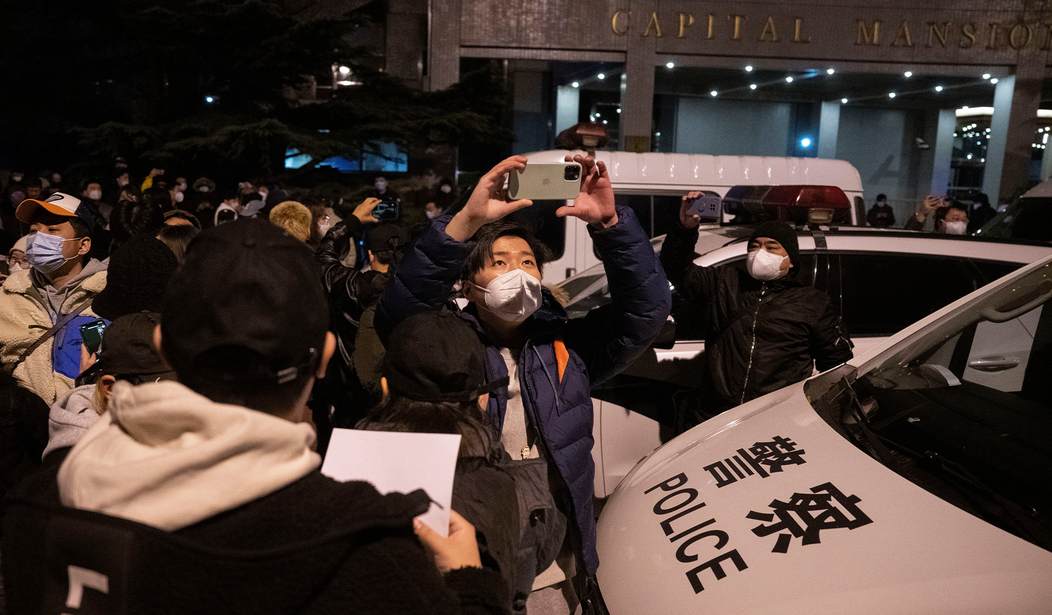Social credit — the automated denial of basic services for “antisocial” behavior — was supposed to serve as the lynchpin of Communist Chinese strongman Xi Jinping’s increasingly totalitarian regime. But nationwide protests may put Xi’s scheme to the test.
If you’re tempted to compare the latest protests to the brutally suppressed Tiananmen Square protests of 1989, that might be a mistake. China specialist Gordon Chang told Fox News Monday, “This is actually more dangerous than 1989, the Tiananmen Square massacre, because then, protesters really wanted to keep the Communist Party in place, but just wanted to replace some hard-line leaders.”
Admittedly, Chang has made a career of predicting the CCP’s downfall, starting (at least) with the 2001 publication of his book, The Coming Collapse of China. There’s a 21-year-old copy on my bookshelves downstairs, serving as a reminder of the folly of making predictions.
But there is still at least some truth in what Chang says. Tiananmen Square was a protest largely of, by, and for college students looking for a somewhat kinder, gentler CCP. Today’s protests are mass events spread throughout the country, and show sometimes-violent frustration with the entire regime — particularly Xi’s “zero COVID” lockdowns.
Protests in China are not rare. What *is* rare, are multiple protests over the same issue, at the same time, across the country. The protest below, apparently in central Beijing’s liangmaqiao, is astounding #China #protests pic.twitter.com/UHJCqqF1YG
— Tom Mackenzie (@TomMackenzieTV) November 27, 2022
That’s the scene at Beijing’s Liangmaqiao subway station in the heart of the capital and near several major embassies including the US, France, Germany, and Japan.
More from Beijing:
People in Beijing marching on the third ring road… singing… and holding up empty white papers…
The empty white paper symbolizes their protest against censorship in China. 🔥🔥🔥
🔊sound …🧐#China #ChinaProtests pic.twitter.com/Rwg24s9Nul
— Wall Street Silver (@WallStreetSilv) November 27, 2022
And here’s Chengdu in Sichuan province:
Anti-lockdown protests in Chengdu getting out of control. Similar pictures arrive from Shanghai, Wuhan, Guangzhou and even Beijing. #China #Chengdu pic.twitter.com/qnktz2b62o
— (((Tendar))) (@Tendar) November 27, 2022
What kicked off scenes like those was this one in Urumqi, where ten locked down people died in a building fire.
There are videos of the screams of the families burning in that building in Urumqi. This is the spark that lit the fuse of the protests across China
"Open the doors! Open the doors! Save us!"
Even children were killed pic.twitter.com/cTSt6F5yXc
— Jack Posobiec 🇺🇸 (@JackPosobiec) November 28, 2022
So what do these protests have to do with Xi’s social credit scheme?
Watch this next clip of Chinese protestors beating back lockdown police with anything they can grab, and then I’ll explain.
China 🇨🇳
Protests are erupting across China as people have had enough of the draconian zero Covid lockdowns. This is what eventually happens when people power mobilises against oppressive governments that take away freedoms and human dignity. pic.twitter.com/NsZgZTxEYT
— James Melville (@JamesMelville) November 27, 2022
Imagine living in a police state with cameras everywhere, transmitting images in realtime to servers equipped with (among other things) facial recognition software. Beijing can easily tell who was where, doing what.
Data is everything. Armed with it, the government can do what Beijing reportedly did: “Chinese government remotely switched all the protesters’s COVID passports to code red.”
China blogger Songpinganq went on to explain that a “Code QR red in China means you need to do your time in a quarantine camp and pay for it.”
It isn’t just COVID passports. Posting impolitic messages on WeChat (China’s Twitter equivalent) can reduce someone’s score to the point where they aren’t allowed to board a plane or a train, hold a job, access their checking account, and more.
Xi’s social credit system is not yet fully developed, but enough of it was in place when COVID struck — or dare I say, escaped? — to implement COVID passports.
The ugly beauty of this electronic dystopia is its insidiousness. Under constant government monitoring, people quickly learn to keep their heads down and their mouths shut — particularly on social media. (This is probably why the Western Left can’t stop wetting their panties over Elon Musk turning Twitter into a free speech platform.) People largely monitor themselves, while the authorities maintain power the easy way.
But what happens when millions of people forget their lessons, take to the streets, and turn against the police, because they’re so desperate that it doesn’t matter any longer if they aren’t allowed to board a commuter train?
Does the computerized system become overloaded and collapse? Do the authorities try to impose their will on so many malcontented workers that the economy fizzles out?
Either possibility might make things very uncomfortable for the CCP elite. “Let’s look for Chinese officials fleeing China, because that could very well be the sign that the end is near,” Chang said to Fox News.
But there is a third possibility: Beijing allows the outbursts to continue, while quietly backing off just enough on Xi’s Zero COVID policy to reduce tensions. People go back to work like nothing happened, and Beijing gives everyone but the ringleaders a pass.
That would probably be the wisest course of action for a Communist regime that seeks to maintain its power more than it cares for any particular policy.
How much wisdom Xi possesses is the real question.
Recommended: Chinese Anti-COVID Lockdown Protests Have Morphed Into Anti-Regime Demonstrations











Join the conversation as a VIP Member